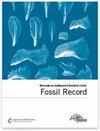下载PDF
{"title":"A simulated bird gastric mill and its implications for fossil gastrolith authenticity","authors":"Oliver Wings","doi":"10.1002/mmng.200800013","DOIUrl":null,"url":null,"abstract":"<p>A rock tumbler, stones, water, plant material, hydrochloric acid, and pepsin were used to simulate a bird gizzard in order to study abrasion rate and influence of stomach juices and foodstuff on gastrolith surface development. The experiment lasted for six months. Each week, the “stomach” was supplied with fresh grass and stomach juices. After the end of the experiment, the set of stones had a combined weight loss of 22.4 %, with softer rock types showing higher abrasion rates. The combination of stomach juices and silica phytoliths within the grass had no visible effect on stone surface development: polish or pitting did not occur. A second experiment combined only pebbles with water in the tumbler. Results indicate that rock abrasion is mainly caused by contacts between moving stones. A comparison with authentic ostrich gastroliths showed that abrasion in the artificial stomach must have been lower than in a real gizzard, but still too high to maintain or develop surface polish. If high polish occasionally seen on sauropodomorph dinosaur gastroliths was indeed caused in a stomach environment, it implies digestive processes different from those of extant birds and the “artificial gizzard”. Geologic origins of polish, such as transport in hyperconcentrated flows, wind blasting, or tectonic movements must be considered for polished fossil gastroliths and isolated clasts in fine-grained sediments (exoliths). (© 2009 WILEY-VCH Verlag GmbH & Co. KGaA, Weinheim)</p>","PeriodicalId":55147,"journal":{"name":"Fossil Record","volume":"12 1","pages":"91-97"},"PeriodicalIF":2.1000,"publicationDate":"2009-02-20","publicationTypes":"Journal Article","fieldsOfStudy":null,"isOpenAccess":false,"openAccessPdf":"https://sci-hub-pdf.com/10.1002/mmng.200800013","citationCount":"7","resultStr":null,"platform":"Semanticscholar","paperid":null,"PeriodicalName":"Fossil Record","FirstCategoryId":"89","ListUrlMain":"https://onlinelibrary.wiley.com/doi/10.1002/mmng.200800013","RegionNum":4,"RegionCategory":"地球科学","ArticlePicture":[],"TitleCN":null,"AbstractTextCN":null,"PMCID":null,"EPubDate":"","PubModel":"","JCR":"Q3","JCRName":"Earth and Planetary Sciences","Score":null,"Total":0}
引用次数: 7
引用
批量引用
Abstract
A rock tumbler, stones, water, plant material, hydrochloric acid, and pepsin were used to simulate a bird gizzard in order to study abrasion rate and influence of stomach juices and foodstuff on gastrolith surface development. The experiment lasted for six months. Each week, the “stomach” was supplied with fresh grass and stomach juices. After the end of the experiment, the set of stones had a combined weight loss of 22.4 %, with softer rock types showing higher abrasion rates. The combination of stomach juices and silica phytoliths within the grass had no visible effect on stone surface development: polish or pitting did not occur. A second experiment combined only pebbles with water in the tumbler. Results indicate that rock abrasion is mainly caused by contacts between moving stones. A comparison with authentic ostrich gastroliths showed that abrasion in the artificial stomach must have been lower than in a real gizzard, but still too high to maintain or develop surface polish. If high polish occasionally seen on sauropodomorph dinosaur gastroliths was indeed caused in a stomach environment, it implies digestive processes different from those of extant birds and the “artificial gizzard”. Geologic origins of polish, such as transport in hyperconcentrated flows, wind blasting, or tectonic movements must be considered for polished fossil gastroliths and isolated clasts in fine-grained sediments (exoliths). (© 2009 WILEY-VCH Verlag GmbH & Co. KGaA, Weinheim)
模拟鸟类胃磨机及其对胃石化石真实性的影响
为了研究胃液和食物对胃石表面发育的影响以及胃液对胃石表面发育的影响,采用岩石杯、石头、水、植物材料、盐酸和胃蛋白酶模拟鸟类胃石。实验持续了六个月。每周,“胃”都被供应新鲜的草和胃液。实验结束后,这组石头的总重量减少了22.4%,较软的岩石类型显示出更高的磨损率。胃液和草中的硅质植岩的组合对石头表面的发育没有明显的影响:没有发生抛光或点蚀。第二个实验只把鹅卵石和水放在玻璃杯里。结果表明,岩石磨损主要是由移动石块之间的接触引起的。与真正的鸵鸟胃石的比较表明,人造胃的磨损程度一定低于真正的砂囊,但仍然过高,无法维持或产生表面抛光。如果偶尔在蜥脚类恐龙胃石上看到的高度抛光确实是在胃环境中造成的,那么它意味着与现存鸟类和“人工砂囊”不同的消化过程。抛光的地质起源,如在高浓度流中运输,风爆破或构造运动,必须考虑抛光化石胃岩和细粒沉积物(剥落岩)中的孤立碎屑。(©2009 WILEY-VCH Verlag GmbH &KGaA公司,Weinheim)
本文章由计算机程序翻译,如有差异,请以英文原文为准。

 求助内容:
求助内容: 应助结果提醒方式:
应助结果提醒方式:


